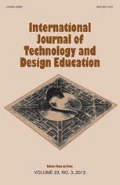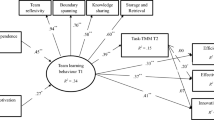Abstract
Engineering education is an emerging field of research. Due to its applied nature, recent theoretical developments have been followed by empirical evidence and interdisciplinary research. The present study attempted to describe the team roles assumed by members of project teams composed of young engineering students. The study was conducted in Pakistan by using the Belbin Team Role Self Perception Inventory. It was found that young Pakistani engineers assumed the roles of implementer, coordinator, shaper and team worker. This study attempts to understand role choices through the framework of national cultural dimensions proposed by Hofstede and engineering education culture offered by Godfrey and Parker. The study strongly recommends that engineering curriculum should incorporate activities which could foster creativity among engineers. Moreover, engineering students should be motivated to innovate through collaboration in a problem and project based environment, which is seriously lacking in engineering education of Pakistan.


Similar content being viewed by others
References
Andersen, A. (2001). Implementation of engineering product design using international student teamwork—To comply with future needs. European Journal of Engineering Education, 26(2), 179–186.
Aritzeta, A., Senior, B., & Swailes, S. (2007). Belbin team role model: Development, validity and applications for team building. Journal of Management Studies, 44(1), 96–118.
Armstrong, J. (1996). Workload in engineering courses and how to reduce it. In Proceedings of 8th Annual Conference of the Australasian Association for Engineering Education. Melbourne, Australia.
Arroba, T., & Wedgwood-Oppenheim, F. (1994). Do senior managers differ in the public and private sectors? Journal of Managerial Psychology, 9, 13–16.
Balderson, S. J., & Broderick, A. J. (1996). Behaviour in teams: exploring occupational and gender differences. Journal of Managerial Psychology, 11, 33–42.
Belbin, M. (1981). Management teams, why they succeed or fail. London: Heinemann.
Borrego, M. (2008). Creating a culture of assessment within an engineering academic department. In Proceedings of IEEE/ASEE frontiers in education conference. Saratoga Springs, NY.
Broucek, W. G., & Randall, G. A. (1996). An assessment of the construct validity of the Belbin self-perception inventory and observer’s assessment from the perspective of the five-factor model. Journal of Occupational and Organizational Psychology, 69, 389–405.
Bucciarelli, L., Einstein, H. H., Terenzini, P. T., & Walser, A. D. (2000). ECSEL/MIT engineering education workshop’ 99: A report with recommendations. Journal of Engineering Education, 89(2), 141–150.
Chen, H. L., Lattuca, L. R., & Hamilton, E. R. (2008). Conceptualizing engagement: Contributions of faculty to student engagement in engineering. Journal of Engineering Education, 97(3), 339–353.
Conole, G., Brasher, A., Cross, S., Weller, M., Clark, P., & Culver, J. (2008). Visualising learning design to foster and support good practice and creativity. Educational Media International, 45(3), 177–194.
Courter, S. S., Millar, S. B., & Lyons, L. (1998). From the students’ point of view: Experiences in a freshman engineering design course. Journal of Engineering Education, 87(3), 283–288.
Cronin, C., & Roger, A. (1999). Theorizing progress: Women in science, engineering, and technology in higher education. Journal of Research in Science Teaching, 36(6), 637–661.
Downey, G. L., & Lucena, J. C. (2005). National identities in multinational worlds: Engineers and “engineering cultures”. International Journal of Continuing Engineering Education and Lifelong Learning, 15(3–6), 252–260.
Felder, R., Brent, R., & Prince, M. (2011). Engineering instructional development: Programs, best practices, and recommendations. Journal of Engineering Education, 100(1), 89–122.
Fisher, S. G., & Macrosson, W. D. K. (1995). Early influences on management team roles. Journal of Managerial Psychology, 10, 8–15.
Fisher, S. G., Macrosson, W. D., & Semple, J. H. (2001). Control and Belbin’s team roles. Personnel Review, 30, 578–588.
Fisher, S. G., Macrosson, W. D. K., & Wong, J. (1998). Cognitive style and team role preference. Journal of Managerial Psychology, 13, 544–557.
Flattau, P. E., Lal, B., Horin, C., Martinez, H., & Ford, J. J, I. I. I. (2009). Early outcomes of the National Science Foundation’s grants program on “How people learn engineering” (HPLE). Washington, DC: Institute for Defense Analyses Science & Technology Policy Institute. (IDA Document D-3725).
Fromm, E., & McGourty, J. (2001). Measuring culture change in engineering education. In Proceedings of the 2001 American Society for Engineering Education annual conference and exposition. Salt Lake City, UT.
Furnham, A., Steele, H., & Pendleton, D. (1993a). A psychometric assessment of the Belbin Team-Role Self-Perception Inventory. Journal of Occupational and Organizational Psychology, 66, 245–257.
Furnham, A., Steele, H., & Pendleton, D. (1993b). A response to Dr Belbin’s reply. Journal of Occupational and Organizational Psychology, 66, 261.
Gilbert, A.-F. (2008). Gender and educational codes in mechanical engineering and materials science: An ethnographic approach. In Proceedings of the research on engineering education symposium (REES). Davos, Switzerland.
Godfrey, E. (2007). Cultures within cultures: Welcoming or unwelcoming for women? In Proceedings of 2007 annual conference and exposition of American Society for Engineering Education. Honolulu, HI.
Godfrey, E., & Parker, L. (2010). Mapping the cultural landscape in engineering education. Journal of Engineering Education, 99, 5–22.
Hofstede, G. (1980a). Culture’s consequences: International differences in work-related values. Beverly Hills, CA: Sage.
Hofstede, G (1980b). Motivation, leadership and organization: Do American theories apply abroad? Organizational Dynamics, Summer, 42–63.
Hofstede, G. (1991). Cultures and organizations: Software of the mind. London: McGraw-Hill.
Hofstede, G. (1998a). Attitudes, values and organizational culture: Disentangling the concepts. Organization Studies, 19(3), 477–492.
Hofstede, G. (2001). Culture’s consequences: Comparing values, behaviors, institutions and organizations across nations (2nd edn.). Thousand Oaks, CA: Sage.
Hofstede, G. & Associates (1998b) Masculinity and femininity: The taboo dimension of national cultures. Thousand Oaks, CA: Sage.
Hofstede, G., & Peterson, M. F. (2000). National values and organizational practices. In N. M. Ashkanasy, C. P. M. Wilderom, & M. F. Peterson (Eds.), Handbook of organizational culture and climate (pp. 401–405). London: Sage.
Johri, A. (2010). Creating theoretical insights in engineering education. Journal of Engineering Education, 99(3), 183–184.
Johri, A., & Olds, B. (2011). Situated engineering learning: Bridging engineering education research and learning sciences. Journal of Engineering Education, 100(1), 151–185.
Kelly, K., & M. Murphy. (2007). Academic change in higher education in Europe. In Proceedings of the 2007 annual conference and exposition of American Society for Engineering Education. Honolulu, HI.
Kemnitzer, S. (2008). The need for theory-based research in engineering education. Video interview recorded at ASEE 2008. Available online at CASEE video channel on YouTube: http://www.youtube.com/watch?v=nfsh08jHEKs.
Khilji, S. E. (2004). Whither tradition? Evidence of generational differences in HR satisfaction from Pakistan. International Journal of Cross Cultural Management, 4(2), 141–156.
Lattuca, L. R., Terenzini, P. T., & Volkwein, J. F. (2006). Engineering change: A study of the impact of EC2000. Baltimore, MD: ABET Inc.
Lewis, S., Mclean, C., Copeland, J., & Lintern, S. (1998). Further explorations of masculinity and the culture of engineering. Australasian Journal of Engineering Education, 8(1), 59–78.
McKenna, A., Hutchison, M., & Trautvetter, L. (2008). The engineer of 2020: Case studies of organizational features of effective engineering education. In Proceedings of research in engineering education symposium. Davos, Switzerland.
Moos, R. H., & Moos, B. S. (1986). Family environment scale manual (2nd ed.). Palo Alto, CA: Consulting Psychologists Press.
NSF-GSE, Research on Gender in Science and Engineering Program (2010). New formulas for America’s workforce. Retrieved from: http://www.nsf.gov/pubs/2003/nsf03207/nsf03207.pdf.
Ohland, M. W., Sheppard, S. D., Lichtenstein, G., Eris, O., Chachra, D., & Layton, R. A. (2008). Persistence, engagement, and migration in engineering programs. Journal of Engineering Education, 97(3), 259–278.
Routamaa, V. & Hautala, T. M. (2008). Understanding cultural differences—The values in a cross-cultural context. The International Review of Business Research Papers, 4, 5.
Seidman, A. (Ed.). (2005). College student retention: Formula for student success. Westport, CT: Praeger, American Council on Higher Education series on Higher Education.
Senior, B., & Swailes, S. (1998). A comparison of the Belbin self perception inventory and observer’s assessment sheet as measures of an individual’s team roles. International Journal of Selection and Assessment, 6(1), 1–8.
Shi, Y., & Tang, H. K. (1997). Team roles behaviour and task environment: an exploratory study of five organizations and their managers. Journal of Managerial Psychology, 12, 88–94.
Smith, K. A., Sheppard, S. D., Johnson, D. W., & Johnson, R. T. (2005). Pedagogies of engagement: Classroom-based practices. Journal of Engineering Education, 94(1), 87–101.
Sondergaard, M. (1994). Hofstede’s consequences—A study of reviews, citations, and replications; special issue on cross-national organization culture. European Group for Organizational Studies, 15(3), 447–456.
Stevens, R., Amos, D. L., Jocuns, A., & Garrison, L. (2007). Engineering as lifestyle and a meritocracy of difficulty: Two pervasive beliefs among engineering students and their possible effects. In Proceedings of the 2007 American Society for Engineering Education annual conference and exposition. Honolulu, HI.
Stevens, R., O’Connor, K., Garrison, L., Jocuns, A., & Amos, D. L. (2008). Becoming an engineer: Toward a three dimensional view of engineering learning. Journal of Engineering Education, 97(3), 355–368.
Streveler, R., & Smith, K. (2006). Conducting rigorous research in engineering education. Journal of Engineering Education, 95(2), 103–105.
Tonso, K. L. (1996). Student learning and gender. Journal of Engineering Education, 85(2), 143–150.
Tonso, K. L. (2006). Teams that work: Campus culture, engineer identity, and social interactions. Journal of Engineering Education, 95(1), 25–37.
Tuckman’s, I. (1965). 5 Stages of group development. Psychological Bulletin, 63, 384–399.
van Dierendonck, D., & Groen, R. (2011). Belbin revisited: A multitrait-multimethod investigation of a team role instrument. European Journal of Work and Organizational Psychology, 20(3), 345–366.
Zampetakis, L. A., Tsironis, L., & Moustakis, V. (2007). Creativity development in engineering education: The case of mind mapping. Journal of Management Development, 26(4), 370–380.
Author information
Authors and Affiliations
Corresponding author
Rights and permissions
About this article
Cite this article
Ibn-e-Hassan, Talib, N.A., Riaz, A. et al. Influence of national and engineering culture on team role selection. Int J Technol Des Educ 24, 91–105 (2014). https://doi.org/10.1007/s10798-013-9242-z
Published:
Issue Date:
DOI: https://doi.org/10.1007/s10798-013-9242-z




